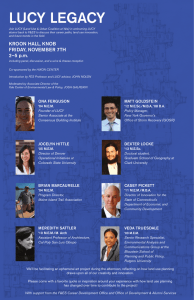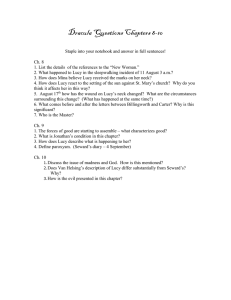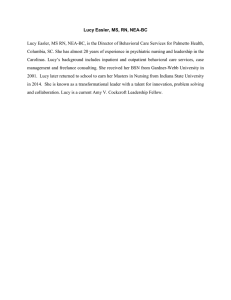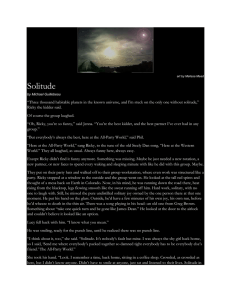Proper Time Speed of light Comparing inertial frames
advertisement
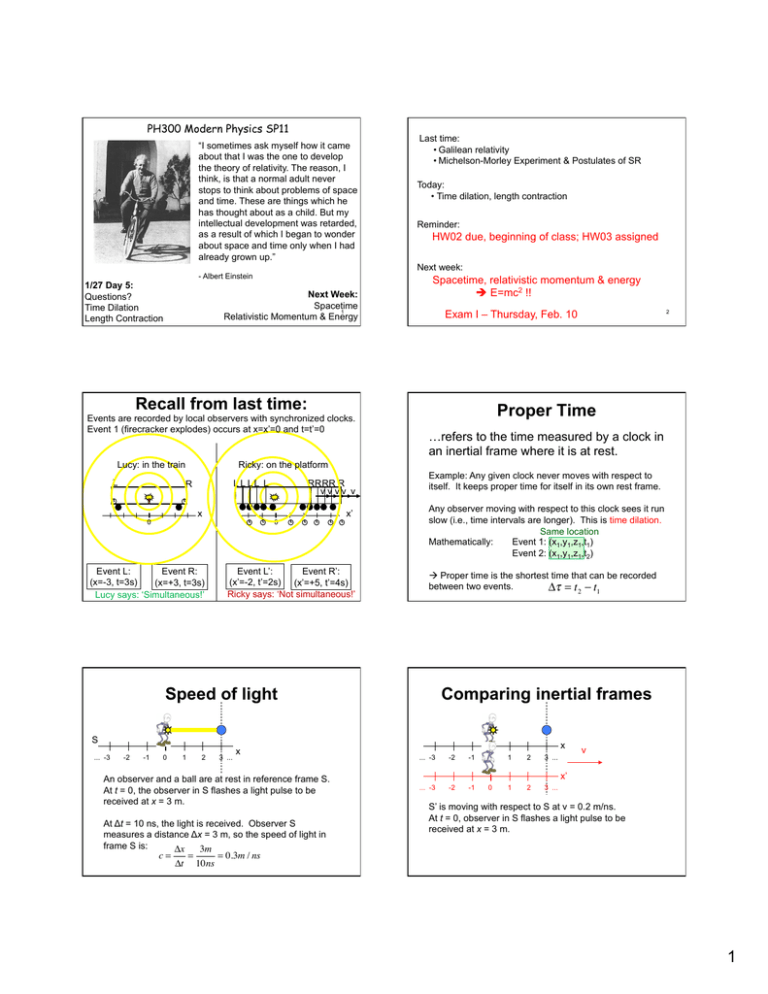
PH300 Modern Physics SP11 “I sometimes ask myself how it came about that I was the one to develop the theory of relativity. The reason, I think, is that a normal adult never stops to think about problems of space and time. These are things which he has thought about as a child. But my intellectual development was retarded, as a result of which I began to wonder about space and time only when I had already grown up.” Today: • Time dilation, length contraction Reminder: HW02 due, beginning of class; HW03 assigned Next week: - Albert Einstein 1/27 Day 5: Questions? Time Dilation Length Contraction Last time: • Galilean relativity • Michelson-Morley Experiment & Postulates of SR Next Week: Spacetime 1 Relativistic Momentum & Energy Spacetime, relativistic momentum & energy è E=mc2 !! Exam I – Thursday, Feb. 10 Recall from last time: Events are recorded by local observers with synchronized clocks. Event 1 (firecracker explodes) occurs at x=x’=0 and t=t’=0 Lucy: in the train L Proper Time …refers to the time measured by a clock in an inertial frame where it is at rest. Ricky: on the platform LLLL L R x 0 Event L: Event R: (x=-3, t=3s) (x=+3, t=3s) Lucy says: ‘Simultaneous!’ R R RR R vvvv v 0 x’ Event L’: Event R’: (x’=-2, t’=2s) (x’=+5, t’=4s) Ricky says: ‘Not simultaneous!’ Example: Any given clock never moves with respect to itself. It keeps proper time for itself in its own rest frame. Any observer moving with respect to this clock sees it run slow (i.e., time intervals are longer). This is time dilation. Same location Mathematically: Event 1: (x1,y1,z1,t1) Event 2: (x1,y1,z1,t2) à Proper time is the shortest time that can be recorded between two events. Δτ = t 2 − t1 Speed of light Comparing inertial frames S ... -3 -2 -1 0 2 1 2 3 ... x An observer and a ball are at rest in reference frame S. At t = 0, the observer in S flashes a light pulse to be received at x = 3 m. At Δt = 10 ns, the light is received. Observer S measures a distance Δx = 3 m, so the speed of light in frame S is: Δx 3m c= = = 0.3m / ns Δt 10ns x ... -3 -2 -1 0 1 2 3 ... ... -3 -2 -1 0 1 2 3 ... v x’ S’ is moving with respect to S at v = 0.2 m/ns. At t = 0, observer in S flashes a light pulse to be received at x = 3 m. 1 Ten nanoseconds later ... -3 -2 -1 ... -3 0 1 2 3 ... -2 -1 0 1 v 2 Ten nanoseconds later ... -3 -2 3 ... -1 ... -3 S’ is moving with respect to S at v = 0.2 m/ns. At Δt = 10 ns, the light is received. In Galilean relativity, how far does the observer in S’ think the light has traveled? a) 3 m b) 2 m c) 1 m d) 0 m 0 1 2 3 ... -2 -1 0 1 v 2 3 ... S’ is moving with respect to S at v = 0.2 m/ns. At Δt=10 ns, the light is received. In Galilean relativity, (Δt=Δt’) the observer in S’ would therefore measure the speed of light as Δx ' 1m c= = = 0.1m / ns Uh-oh! Δt ' 10ns Another argument for time dilation Uh-oh! If we are to believe Einstein’s postulate, then: Mirror In frame S Lucy h v In frame S’ Conclusion: Since we accepted Einstein's postulate of relativity (‘c’ is the same in all inertial frames) and we found that , we conclude that . I.e., time passes at different rates in the two frames of reference!! Lucy measures the time interval: Δt (Not a big surprise!) Another argument for time dilation Another argument for time dilation Mirror h = 2h/c ’ Δt / 2 c· v h v · Δt’/2 Ethel Ethel Ricky Note: This experiment requires two observers. ( h + v ⋅ Δt ' 2 2 ( ) (Δt ')2 c 2 − v 2 = (2h)2 ) ( 2 = c ⋅ Δt ' 2 ) Ricky 2 2 ⎞ 1 ⎛ 2h ⎞ ⎛ (Δt ')2 = ⎜ ⎟ ⎜ 2⎟ ⎝ c ⎠ ⎝ 1 − (v c) ⎠ 2 Another argument for time dilation Time dilation in moving frames Lucy measures: Δt Ethel and Ricky: Δt’ = γΔt, with ’ Δt / 2 c· h v · Δt’/2 Ricky Ethel Ethel and Ricky measure the time interval: The γ-factor can take on what values? But Lucy measured Δt = 2h/c !! Time dilation in moving frames A) −∞ < γ < ∞ D) 1≤γ < ∞ B) 0 <γ ≤1 C) 0≤γ <∞ E) Something else… What we found so far: Simultaneity of two events depends on the choice of the reference frame Lucy measures: Δt Ethel and Ricky: Δt’ = γΔt, with L R v Lucy …-3 -2 -1 0 1 2 3... Ricky Δt’ = γΔt ≥ Δt Lucy concludes: Light hits both ends at the same time. For Lucy time seems to run slower! Ricky concludes: Light hits left side first. (Lucy is moving relative to Ethel and Ricky) What we found so far: Time Dilation: Two observers (moving relative to each other) can measure different durations between two events. h Lucy v h Are your clocks really synchronized? (I know mine are!) Ethel Lucy measures: Δt = 2h/c Here: Δt =Δτ is the proper time Ricky Ethel and Ricky: Δt’ = γ 2h/c with 3 L R -2 -1 0 R v Lucy ... -3 L 1 2 v Lucy 3 ... ... -3 -2 -1 Ricky 0 1 2 3 ... Ricky Now Lucy and Ricky each have a set of clocks. Lucy’s are synchronized in her frame (the train), while Ricky’s are synchronized in his frame (the tracks). At 3 o’clock in Ricky’s frame, two firecrackers go off to announce the time. It so happens that these firecrackers are at the left and right ends of the train, in Ricky’s frame. How do the clocks of one frame read in another frame? Event 1: firecracker 1 explodes at 3:00 Event 2: firecracker 2 explodes at 3:00 L R -2 -1 0 R RRR v Lucy ... -3 L L LL 1 2 v vvv Lucy Lucy Lucy Lucy 3 ... ... -3 Ricky -2 -1 0 1 2 3 ... Ricky Event 1: firecracker 1 explodes at 3:00 Event 2: firecracker 2 explodes at 3:00 When Lucy sees each flash from the two firecrackers, she sees that Ricky’s clocks both read 3:00 when each of the firecrackers went off. The situation as seen by Lucy Sometime later, the wavefronts meet. The meeting point is halfway between the firecrackers in Ricky’s frame, but is somewhere toward the left in the train car, in Lucy’s frame. Event 3: two light pulses meet, shortly after 3:00. L R Lucy L R Lucy Ricky Ricky In Lucy’s frame, light left first from the right end of the car. The light pulses both show clocks reading 3:00 in Ricky’s frame. According to Lucy’s reference frame, which of the following is true: A) Ricky’s clock on the left reads a later time than Ricky’s clock on the right. B) Ricky’s clock on the right reads a later time than Ricky’s clock on the left. C) Both of Ricky’s clocks read the same time. 4 Important conclusion In Lucy’s frame: L Clocks in S’ (synchronized in S’) moving to the left with respect to S R Lucy v S’ Ricky This clock reads a little after 3:00 in S If this clock reads 3:00 in S, then: S This clock reads even a little later in S Clocks in S’ as seen by observer in S Even though the clocks in S’ are synchronized (in S’) the observer in S sees each clock showing a different time!! ‘Proper length’ Length of an object ... -3 -2 -1 0 1 2 3 ... This length, measured in the stick’s rest frame, is its proper length. This stick is 3m long. I measure both ends at the same time in my frame of reference. Proper length: Length of object measured in the frame where it is at rest (use a ruler) “Same time” or not doesn’t actually matter here, because the stick isn’t going anywhere. ... -3 Remember ‘proper time’ -1 0 1 2 3 ... Length of an object Proper time: Time interval Δτ = t 2 − t1 between two events measured in the frame where the two events occur at the same spatial coordinate, i.e. a time interval that can be measured with one clock. Observer in S measures the proper length L of the blue object. S ... -3 v -2 -2 -1 S’ 0 0 1 2 3 ... v Another observer comes whizzing by at speed v. This observer measures the length of the stick, and keeps track of time. Event 1 – Origin of S’ passes left end of stick. 5 A little math Length of an object S ... -3 -2 -1 0 1 S’ 2 v 3 ... 0 Event 1 – Origin of S’ passes left end of stick. Event 2 – Origin of S’ passes right end of stick. S’ In frame S: (rest frame of the stick) length of stick = L (this is the proper length) time between events = Δt speed of frame S’ is v = L/Δt Speeds are the same (both refer to the relative speed). And so v In frame S’: length of stick = L’ (this is what we’re looking for) time between events = Δt’ = Δτ speed of frame S is -v = -L’/Δt’ b) Δt = γ Δt’ Q: a) Δt = Δt’ A little math S Follow the proper time! c) Δt’ = γ Δt The Lorentz transformation S v S’ x’ 0 Length in stick’s rest frame (proper length) Length in moving frame Length contraction is a consequence of time dilation (and vice-versa). Lorentz transformation An observer at rest in frame S sees a stick flying past him with velocity v: S 0 v x’ As viewed from S, the stick’s length is x ' γ . Time t passes. According to S, where is the right end of the stick? (Assume the left end of the stick was at the origin of S at time t=0.) A) x = γ vt B) x = vt + x ' γ D) x = vt − x ' γ Event 1 – left of stick passes origin of S. Its coordinates are (0,0) in S and (0,0) in S’. The Lorentz transformation S x S’ A stick is at rest in S’. Its endpoints are the events (x,t) = (0,0) and (x’,0) in S’. S’ is moving to the right with respect to frame S. C) x = −vt + x ' γ v S’ 0 x’ x = vt + x ' γ This relates the spatial coordinates of an event in one frame to its coordinates in the other. Algebra x ' = γ (x − vt) E) Something else… 6 Transformations If S’ is moving with speed v in the positive x direction relative to S, then the coordinates of the same event in the two frames are related by: Galilean transformation (classical) Lorentz transformation (relativistic) A note of caution: The way the Lorentz and Galileo transformations are presented here assumes the following: An observer in S would like to express an event (x,y,z,t) (in his frame S) with the coordinates of the frame S', i.e. he wants to find the corresponding event (x',y',z',t') in S'. The frame S' is moving along the x-axes of the frame S with the velocity v (measured relative to S) and we assume that the origins of both frames overlap at the time t=0. y y' (x,y,z,t) S S' x z Note: This assumes (0,0,0,0) is the same event in both frames. Transformations If S’ is moving with speed v in the positive x direction relative to S, then the coordinates of the same event in the two frames are related by: Galilean transformation (classical) Lorentz transformation (relativistic) Δx ′ = γ (Δx − vΔt) Δy′ = Δy Δz′ = Δz Δx ′ = Δx − vΔt Δy′ = Δy Δz′ = Δz Δt ′ = Δt Δt ′ = γ (Δt − Lucy v Δx) c2 (x',y',z',t') v x' z' Lucy v ? ... -3 -2 -1 0 George 1 2 3 ... George has a set of synchronized clocks in reference frame S, as shown. Lucy is moving to the right past George, and has (naturally) her own set of synchronized clocks. Lucy passes George at the event (0,0) in both frames. An observer in George’s frame checks the clock marked ‘?’. Compared to George’s clocks, this one reads A) a slightly earlier time B) a slightly later time C) same time v ? ... -3 -2 -1 0 1 George 2 3 ... The event has coordinates (x = -3, t = 0) for George. In Lucy’s frame, where the ? clock is, the time t’ is , a positive quantity. ‘?’ = slightly later time 7
